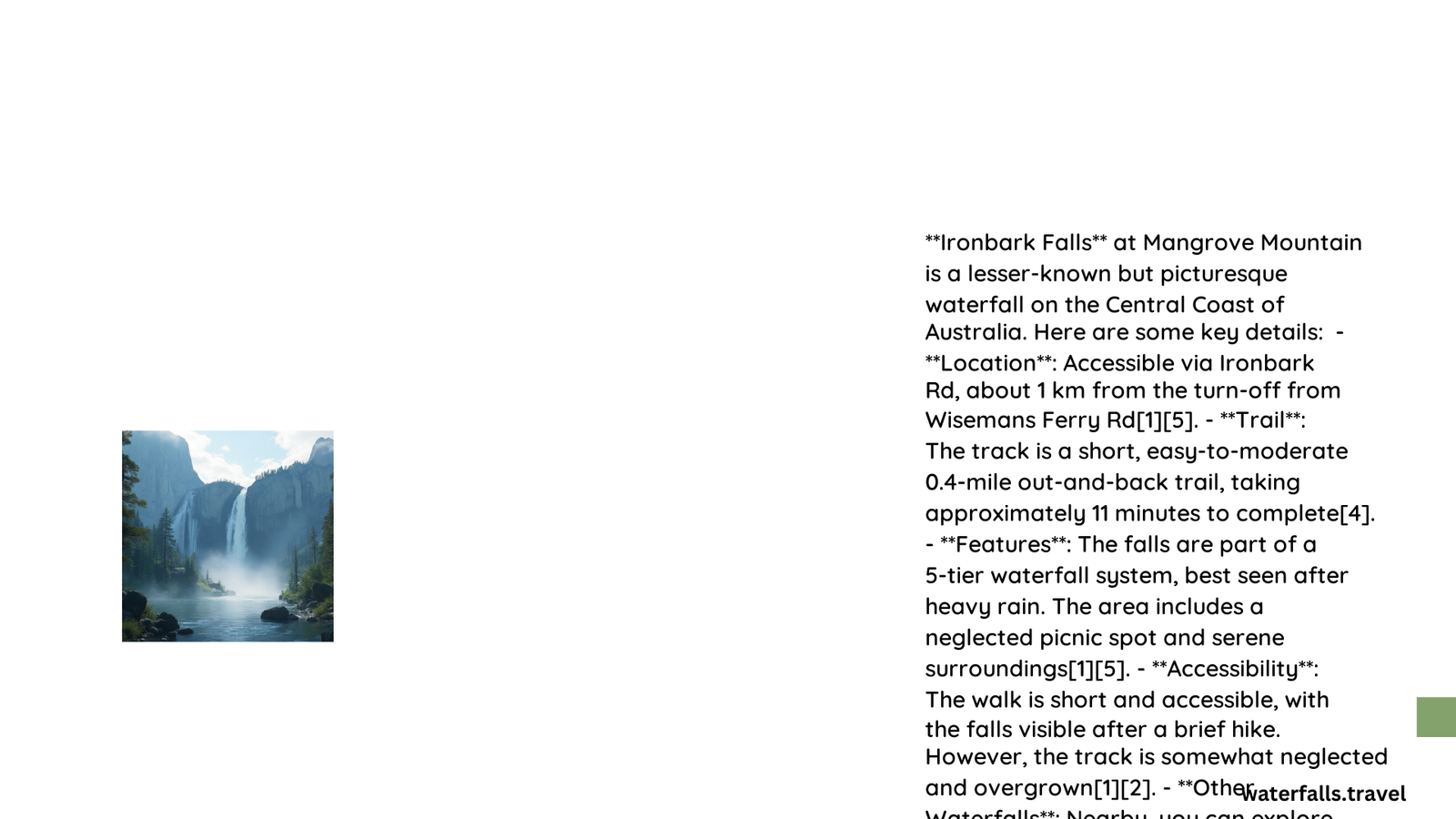Ironbark Falls, located near Mangrove Mountain in the Central Coast Region of New South Wales, Australia, is a secluded natural wonder. This five-tiered waterfall, accessible via a moderate bushwalk, offers visitors a serene escape into nature. Despite its lack of signage and facilities, the falls attract hikers and nature enthusiasts seeking to explore the hidden beauties of the region. The waterfall’s picturesque setting, surrounded by lush bushland and featuring a sandy clearing, makes it a rewarding destination for those willing to venture off the beaten path.
Where is Ironbark Falls Mangrove Mountain Located?
Ironbark Falls is situated in the Central Coast Region of New South Wales, Australia. It’s located inland northwest of Gosford, near the area known as Mangrove Mountain. The nearest major towns are Gosford and Wyong, making it accessible for day trips from these urban centers.
To reach the falls, visitors need to navigate to the remains of Ironbark Reserve. However, it’s important to note that there is no official signage directing you to the falls. This lack of markers adds to the adventure but also necessitates careful planning and navigation.
How Can Visitors Access Ironbark Falls?

Accessing Ironbark Falls requires some preparation and navigation skills. Here are the key points to consider:
-
GPS Navigation: Due to the lack of signage, using GPS coordinates is essential. While exact coordinates aren’t publicly shared to preserve the site, you can use mapping apps or websites to locate the Ironbark Falls Track.
-
Starting Point: The hike begins at the remains of Ironbark Reserve.
-
Trail Name: The path to the falls is known as the Ironbark Falls Track.
-
Difficulty: The trail is considered moderate due to the terrain and lack of clear markers.
-
Length and Duration: While exact measurements aren’t provided, it’s described as a short to moderate walk, suitable for a day hike.
What Can Visitors Expect at Ironbark Falls?
Upon reaching Ironbark Falls, visitors are rewarded with a stunning natural spectacle. Here’s what to expect:
- Waterfall Structure: A five-tiered waterfall cascading down the rocky terrain.
- Surrounding Area: The falls are set in a small clearing with a sandy area in front, perfect for resting and admiring the view.
- Natural Beauty: Lush bushland surrounds the falls, offering a pristine natural environment.
- Seasonal Variations: The waterfall’s flow is significantly more impressive after periods of rain, making wet seasons the ideal time to visit.
Are There Any Facilities at Ironbark Falls Mangrove Mountain?
Ironbark Falls is a natural, undeveloped site. As such, facilities are minimal:
| Facility Type | Availability |
|---|---|
| Parking | Limited, near track start |
| Rest Areas | None officially designated |
| Visitor Centers | None |
| Signage | None |
| Organized Tours | Not available |
The lack of facilities contributes to the area’s unspoiled charm but requires visitors to be well-prepared for their hike.
What Should Hikers Prepare for the Ironbark Falls Track?
Given the remote nature of Ironbark Falls, proper preparation is crucial. Here’s a checklist for hikers:
- Navigation Tools: Reliable GPS device or smartphone with offline maps
- Water: Sufficient supply for the entire hike
- Snacks: Energy-boosting foods for the trail
- Appropriate Footwear: Sturdy hiking shoes with good grip
- Weather-appropriate Clothing: Including sun protection or rain gear
- First Aid Kit: Basic supplies for emergencies
- Camera: To capture the beautiful scenery
- Leave No Trace: Carry out all trash and respect the environment
Why is Ironbark Falls Mangrove Mountain Worth Visiting?
Ironbark Falls offers a unique experience for several reasons:
-
Natural Beauty: The five-tiered waterfall set in pristine bushland provides stunning views and photo opportunities.
-
Secluded Location: Its off-the-beaten-path nature means fewer crowds and a more intimate experience with nature.
-
Adventure Factor: The lack of signage and facilities adds an element of adventure to the hike.
-
Diverse Ecosystem: The surrounding bushland is home to various flora and fauna, offering nature enthusiasts plenty to observe.
-
Seasonal Changes: Visiting during different seasons offers varied experiences, from lush greenery in spring to powerful water flow after rains.
How Does Ironbark Falls Compare to Other Central Coast Waterfalls?
While the Central Coast region boasts several waterfalls, Ironbark Falls stands out for its:
- Seclusion: Less visited than more popular falls in the region
- Natural State: Minimal human intervention preserves its wild character
- Unique Structure: The five-tiered formation is relatively uncommon
- Accessibility: Despite being hidden, it’s still reachable within a day trip from nearby towns
What is the Best Time to Visit Ironbark Falls Mangrove Mountain?
The ideal time to visit Ironbark Falls depends on your preferences:
- Wet Season: After periods of rain, the waterfall is at its most impressive, with strong water flow creating a spectacular sight.
- Dry Season: While the water flow may be reduced, the hike can be more comfortable, and the surrounding bushland equally beautiful.
- Weekdays: For those seeking solitude, weekdays typically see fewer visitors.
- Early Mornings: Offer the best light for photography and a peaceful atmosphere.
Remember to always check weather conditions and park alerts before setting out on your hike.
How Can Visitors Contribute to Preserving Ironbark Falls?
Preserving the natural beauty of Ironbark Falls is crucial for future generations to enjoy. Visitors can contribute by:
- Adhering to Leave No Trace principles
- Staying on designated trails to prevent erosion
- Not removing any natural objects or disturbing wildlife
- Reporting any signs of damage or misuse to local authorities
- Sharing the importance of conservation with fellow hikers
By respecting this hidden gem, we ensure that Ironbark Falls Mangrove Mountain remains a pristine natural wonder for years to come.
References:
1. Hiking the World: Ironbark Creek Falls
2. AllTrails: Ironbark Falls Track
3. Out Lost: Secret Waterfall On The Central Coast: Ironbark Falls
